Science of Onions -- Best way to dice an onion
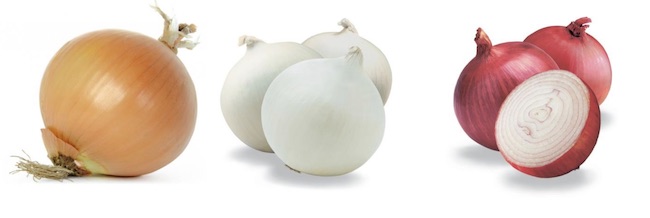
The onion is one of the most used vegetables in cooking. Shown above are yellow, white and red onions from the state of New Jersey. The white onions tend to be sharper than the yellow onion. The red onion is similar in taste to the yellow onion and is used in raw preparations such as salsa and salads.
The onion (Allium cepa L.,--species-- from Latin cepa "onion"), also known as the bulb onion or common onion, is a vegetable that is the most widely cultivated species of the genus Allium. Its close relatives from the Alliu genus include the garlic, scallion, shallot, leek, chive, and Chinese onion also known as Chinese scallion.
Note: Onions are toxic to dogs and cats-- "...Onions contain a toxic principle known as N-propyl disulfide. This compound causes a breakdown of red blood cells, leading to anemia in dogs. The toxin causes oxidative damage to your dog's red blood cells by attaching to the oxygen molecules in your dog's red blood cells..."source
L. The onion (Allium cepa L., from Latin cepa "onion"), also known as the bulb onion or common onion, is a vegetable that is the most widely cultivated species of the genus Allium. The Allium genus includes garlic, onions, shallots, leeks, and chives. These vegetables are popular in cuisines worldwide and are valued for their potential medicinal properties. The family that these vegetable belong to is the Amaryllidaceae which t are a family of herbaceous, mainly perennial and bulbous (rarely rhizomatous) flowering plants.
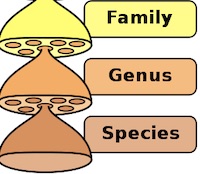
Note on species vs. genus-- The main difference between species and genus is the taxonomic rankings that are used for biological classifications of organisms. Genus belongs to a ranking lower than family and above species, whereas species are organisms with similar characteristics that come below the Genus classification ranking. --Onion, (Allium cepa), herbaceous biennial plant in the amaryllis family (Amaryllidaceae), grown for its edible bulb.
Spring Onions vs. Late Summer Onions
The spring onions are planted in the fall for harvesting in the spring...Spring onions have a milder taste than most onions. Because spring onions contain a high water content they are best kept wrapped in a moist paper towel inside the refrigerator. The tops of spring onions are edible and taste like scallions.The pungent onions harvested in late summer and early fall can be stored for months. They contain sulfurous compounds (the stuff that makes you cry when you cut them) that help to preserve them.
Types of onions used in cooking: (Note these onions found at Union Square Greenmarket, NYC.
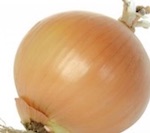
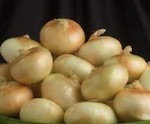

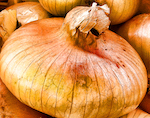

Why eyes tear when cutting onions
Growing plants take up sulfur from the soil and create amino acid sulfoxides which are held in the cell. The enzyme ( lachrymatory-factor synthase see: An onion enzyme that makes the eyes water-- Nature Journal 2002) is held in the plant vacuole. When the cell is damaged or cut the enzyme is released followed by a series of events shown below.
The process goes as follows:
- Lachrymatory-factor synthase is released into the air when we cut an onion.
- The synthase enzyme converts the amino acids sulfoxides of the onion into sulfenic acid.
- The unstable sulfenic acid rearranges itself into syn-ropanethial-S-oxide.
- Syn-propanethial-S-oxide gets into the air and comes in contact with our eyes. The lachrymal glands become irritated and produces the tears!
Source: Why does chopping and onion make you cry. Library of Congress--2019
It is the sulfur-containing compounds that are the flavor precursors that give rise to the characteristic odor and flavor of onions.
Chopped onions that are meant to be eaten raw are best rinsed first to remove the sulfur compounds found on the damaged surfaces.
The National Onion Association recommends chilling an onion for about 30 minutes before cutting the top off and peeling off its outer layers (being sure to leave the root end alone, as it has the highest amount of sulfoxides).
See also: Why do onions make you cry? Science Daily, June, 2017
Storage of Onions
Just as a refrigerator can dehydrate bread and sweeten your potatoes, a similar rule applies to onions, too, which stay good for up to 30 days if you store them the right way (in a cool, dry, dark place -- not in the fridge). The reason being when an onion is chilled, the cold, humid temperatures in a refrigerator convert the starch to sugars, and onions tend to become soft or soggy a lot faster. While the USDA recommends you store them at 45 to 50ºF they will keep for a week at room temperature. In the case of scallions or spring onions a the fridge is better since these vegetables have a higher water content.
Health Benefits of Onions
Onions are know to contain 25 different varieties of flavonoid antioxidants which include a significant level of quercetin. Quercetin may have positive effects in combating or helping to prevent cancer, prostatitis, heart disease, cataracts, allergies/inflammations, and respiratory diseases such as bronchitis and asthma. It also has antidepressant properties. see source. Red onions, in particular, contain anthocyanins, a special plant pigments in the flavonoid family
"...Compounds from onion have been reported to have a range of health benefits which include anticarcinogenic properties, antiplatelet activity, antithrombotic activity, antiasthmatic and antibiotic effects..." source
Red onions are especially high in quercetin and and kaempferol.
Anthocyanins, belonging to anthocyanidins, are mainly present in red onions (250 mg/kg), besides having a composition rich in flavonols as yellow onions source..
"...These studies highlight potential mechanisms of individual sulfur-containing compounds and of various preparations and extracts of these vegetables, including decreased bioactivation of carcinogens, antimicrobial activities, and redox modification. source
Allicin Molecule
Allicin, which is responsible for the smell of onion and garlic, belongs to one of these compound groups and has been shown in animal studies to reduce heart disease, decrease blood pressure, prevent platelet aggregation, suppress certain types of cancer and have anti-inflammatory properties.
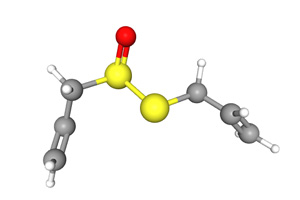
Allicin is an organoscopy compound obtained from garlic, a species in the family Alliaceae. It was first isolated and studied in the laboratory by Chester J. Cavallito and John Hays Bailey in 1944. When fresh garlic is chopped or crushed, the enzyme alliinase converts alliin into allicin, which is responsible for the aroma of fresh garlic. The allicin generated is unstable and quickly changes into a series of other sulfur-containing compounds such as diallyl disulfide. Allicin is part of a defense mechanism against attacks by pests on the garlic plant.
See also: Allicin--Anti-Aging and Senolytic Properties- from World of Molecules
Articles -- health benefits of the Onion Family
Chemical and Biochemical Mechanisms Underlying the Cardioprotective Roles of Dietary Organopolysulfides
Chemical Composition and Antioxidant Properties of Five White Onion (Allium cepa L.) Landraces
Garlic and onions: Their cancer prevention properties
Garlic: a review of potential therapeutic effects
Onion (Allium cepa L.) is potentially a good source of important antioxidants
11 Proven Health Benefits of Garlic
Science of Cooking
See also:
What is the Maillard Reaction?
What are the effects of the Maillard Reaction during cooking?
Health Risks in Cooking
What is the difference between LDL and HDL?
What are the different types of Omega-3 fatty acids?
What is the difference between nitrates and nitrites?
What is the difference between saturated and unsaturated fats?
Science of Cooking
See also: